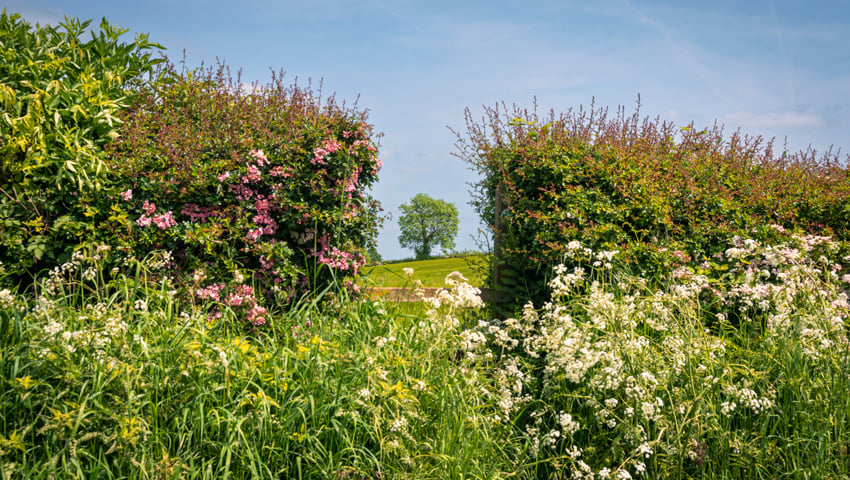THE NATURE Friendly Farming Network in England has responded to Defra’s new consultation on the future of hedgerows, calling for new hedgerows to be created and for those which already exist to be properly protected and maintained.
Defra has asked for views on how hedgerows should be protected as the Common Agricultural Policy (CAP) is replaced with a domestic agriculture policy for England in the wake of the UK leaving the EU.
NFFN CEO Martin Lines said, “Hedgerows bring numerous benefits, from carbon sequestration and natural pest control to flood mitigation, but they are also a part of our countryside’s heritage. Removing basic hedgerow protections runs counter to the need to secure ecosystem functionality in ways that improve farming’s resilience.
“A move to a system of public money for public goods will only be successful if it’s underpinned by a clear regulatory baseline that protects the natural assets that our food production relies upon. It’s a welcome step to see this consultation and we hope that it paves a sensible way forward, where existing hedgerow protections are maintained and subsequently built upon.”
In its response, Nature Friendly Farming Network said Defra should maintain the current levels of protection for hedgerows as an absolute minimum, as hedgerows are crucial natural assets which require well-designed regulations. Government also needs to ensure that hedgerows are not exposed to damaging maintenance practices, that current seasons when hedges cannot be cut are kept in place and that there is a strong programme of monitoring and enforcement so hedgerows can deliver for both farm businesses and nature.
Hedgerows can bring a wealth of benefits for both farms and wider society, but the existing regulations will not be enough on their own unless there are penalties for damaging practices which will act as a deterrent. In addition, the creation of new hedgerows needs to be prioritised alongside protecting those already in existence in order for the UK to meet its ambitious environmental goals.
Defra should consider extending the current two-metre buffer zone around existing hedgerows to four metres to prevent ploughing right up to the edges of fields. There shouldn’t be an exemption for small fields up to two hectares in size or for hedgerows under five years old.
The current no-cutting period, lasting from 1 March to 31 August, should be kept as red-listed endangered birds such as linnets, turtle doves, and yellowhammers have all been observed using hedgerows to breed until the end of August. Farms under five hectares in size should not be exempt from these regulations as that would leave hedgerows on around 15% of agricultural land in England inadequately protected.
In addition, NFFN is calling on Defra to put in place a robust regulatory framework to ensure exemptions to the rules are only granted on a case-by-case basis and that non-compliance is dealt with via a mixture of stop notices, compliance notices, restoration notices and fines.
Defra also needs to create a comprehensive definition of what constitutes a hedge, suggesting its current plan to amend existing regulations could end up with fewer hedgerows being protected than is the case now under cross-compliance regulations.
Farming voices
Arable farmer Patrick Barker, who farms 550 hectares of land in North Suffolk, said, “We’ve got 48 kilometres of hedgerows over a 500-hectare farm, which is a lot. For me, hedges are so important. We want as much variety as we possibly can: tall hedges, short hedges, fat wide hedges, unruly ones. We know wildlife responds well to the different hedgerows.
“One of their main uses is providing a food source for winter and farm birds, but we’re also leaving carbon in the hedgerow and providing hedgehog hibernating habitat.
“We’re planting new hedges as well. I want every single plant in the hedges to have a benefit. Every single hedgerow should be providing everything.”
James Baird, a tenant farmer working on 1300 acres in West Sussex, said, “We have to start somewhere recovering what has been lost and for me, that was hedges. It’s now like going on safari with groups of goldfinches, little families of long-tailed tits, sparrows and starlings. Different things are happening in particular stretches of hedgerow.
“What had a profound effect on me was when in 2019, we had a particularly wet autumn and couldn’t go out into the fields. The following May or June, we would see if the symptoms of barley yellow dwarf virus (BYDV) were present. Next to the hedgerows, everything was bright green, you only saw it about 12 metres into the field. The predators had come out of the hedgerows, and there was no infection at all. I had always been quite sceptical about what insects could offer.
“Defra wants to be looking at local hedgerows and trying where possible to replace the dominant species in a variety of areas, rather than it being a national picture. My big worry is that unscrupulous people would be able to grub out what has been planted and take money to put them back in again.”
Helen Rhodes, an arable farmer in the North East of England, said, “There needs to be a recognition of the value of what, in our case, is effectively a 7m vertical floristically-enhanced margin, stuffed full of pollen and nectar in spring and berries in autumn. There needs to be a recognition of the cost of maintaining a network of hedges as wildlife corridors around small fields and mature hedges are seriously undervalued.”
